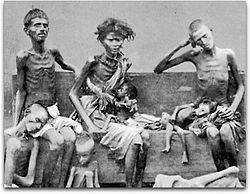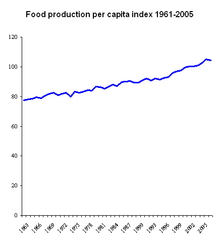Famine
The famine is a situation that occurs when a country or geographical area does not have enough food and resources to provide food for the population, raising the mortality rate due to hunger and malnutrition.
According to the United Nations Project Hunger, about 24,000 people die every day from hunger or hunger-related causes. Taking into account that the total daily deaths from all causes is approximately 150,000 people, deaths from hunger reach 16% of the total. 75% of the deceased are children under five months of age. The Institute for Food Policy and Development states that famine and wars cause only 10% of deaths. Most starvation deaths are due to chronic malnutrition. Families do not get enough food due to different causes, such as poverty, war or natural disasters. The Food and Agriculture Organization of the United Nations (FAO) estimates that between 1970 and 1980 chronic hunger affected 842,000,000 people in the world.
There was a long period of famine in Europe in the early 17th century century. At that time, cities were growing rapidly and, in years of bad harvests, the inhabitants of urban centers with greater purchasing power could buy food while a large part of the population, including the farmers themselves, could not.
Great Famines
19th century famines
Famine in Ireland
In 1845, there was a great famine in Ireland. Before, half of the island's population (eight million inhabitants) lived mainly on potatoes, a tuber native to South America.
The 1845 crop was destroyed by a fungus (Phytophthora infestans) known as rust, which arrived in Europe from North America. Thousands of people flooded into towns and cities seeking help, sparking epidemics of typhoid, cholera, and dysentery and rendering the efforts of government, landlords, and poor-relief organizations insufficient. By 1848, Ireland had lost a million people, most of them dying from starvation or disease, and more than a million emigrated to other countries.
Famine in India
At the end of the 19th century, India experienced a series of frequent and devastating famines, the most catastrophic being this country knew. Approximately 25 outbreaks of famine swept through the Indian states of Tamil Nadu in southern India, Bihar in the north and Bengal in the east, killing between 30 and 40 million Indians.[citation needed]
The famines were the result of climatic problems with changes in the rainfall regime that alternated droughts with floods. But they were also caused by the administration of the British, when lands cultivated by the Indians with products for their subsistence and food were replaced by tea and cotton plantations. Also the restrictions on internal trade and the high taxes to which the Indian settlers were subjected and the disastrous war with Afghanistan caused great inflation and a substantial export of products from India to the United Kingdom.
Some citizens, such as William Digby, advocated for legal reform and famine relief, but the Governor-General at the time, Lord Lytton, opposed any change. These famines continued until independence from British rule, one of the main ones being the one that occurred in the city of Bengal in 1943, claiming the lives of another three million inhabitants.
Famines of the 20th century
Famine in the Soviet Union
In the winter of 1932 and 1933 there was a famine in parts of the Soviet Union, particularly the Volga, and in the Ukrainian SSR and Kazakhstani SSR (north), but this one, unlike the one in 1921, it was mainly caused artificially. Stalin, who had come to power in 1924, began a policy of collectivization of agriculture in the Soviet Union. Since most of the peasants did not own property, they enthusiastically welcomed the new policy, the owners resisted it, sometimes reacting violently, breaking out numerous riots. Determined to put down the riots, Stalin sent in the Red Army, capturing thousands of dissidents and sending them to labor camps in Siberia or shooting them. At the same time, the food quota that the republics had to deliver (particularly Ukraine) was increased, creating a food vacuum in the most fertile regions, and thus beginning a massive and prolonged famine in the place considered the "Barn of the USSR". It is estimated that the number of victims amounted to 3.5 million people. At the height of the famine, as many as 25,000 people died every day. This event has received the name of Holodomor (in Russian Golodomor).[citation required]
Famine in Ethiopia
In the early 1970s, a drought situation in Ethiopia, exacerbated by the feudal backwardness of Ethiopian agriculture, reduced food production in much of the country, leading to famine that caused nearly 300,000 deaths in the provinces of Welo and Tigray. This situation, which was kept hidden so as not to affect the international popularity of Haile Selassie, together with political instability and resistance to population relocation policies, contributed to the weakening of the regime and to the overthrow of the monarchy.
Without being able to recover from this catastrophe, in the early 1980s a major drought struck the impoverished rural population of Ethiopia, causing a great famine that left nearly a million dead. Within this framework, hundreds of thousands of people fled from economic misery, seeking refuge abroad. The famine was exacerbated by the enormous concentration of population in the areas most affected by the drought and by the inability of the government to deal with it, which, as in the time of the emperor, tried unsuccessfully to settle the population in other areas, facing criticism. of the international community, contrary to the forced resettlement of the population. At the beginning of 1985, some 7.7 million people still suffered from food shortages, of which 2.5 million were at direct risk of hunger.
Famine in Spain
Some 200,000 people died of starvation in Spain during the post-war period of the Spanish Civil War, that is, between 1939 and 1945. A 1941 study showed that the average Spaniard received only 66% of the necessary calories. By comparison, the situation in Spain was much worse than in Nazi-occupied France or the Netherlands, even during the notorious Dutch famine of 1944, when the Nazis killed 30,000 Dutch people, a smaller proportion of the population.
The famine was not a product of the Civil War, nor of boycotts of Spain by other countries. It has its roots in the failed policy of autarky chosen by the Franco government. In addition, the food rationing system was distorted with impunity by officials and local chiefs.
The Franco regime hid the existence of this famine, and it is little known in Spain.
Artificial famine
Artificial famine is the insufficiency of food due to deliberately provoked factors. It occurs in environmentally suitable regions to support their population but where their inhabitants suffer from hunger (in extreme cases, the necessary food is produced, but the population is deprived of using it).
On September 16, 2009, the WFP (or World Food Program), a specialized agency of the United Nations Organization announces that "world food aid is at its lowest level in the last twenty years, despite that the number of people in a critical state of famine is skyrocketing in 2009 to its highest point in history. The agency also reports that enough food is produced in the world to feed all its inhabitants, but that the problem lies in the low efficiency in getting it to those who need it.
One of the causes of artificial famine can be hyperinflation and hyperdevaluation of the local currency, which greatly contributes to the high cost and inaccessibility of food necessary for subsistence. This is the case of countries such as Zimbabwe, Angola, Somalia and Venezuela (the latter since 2017).
Famine Fighting Organizations
- FAO
- NGOs
Contenido relacionado
Codex Alimentarius Austriacus
Tartrazine
Pepperoni


